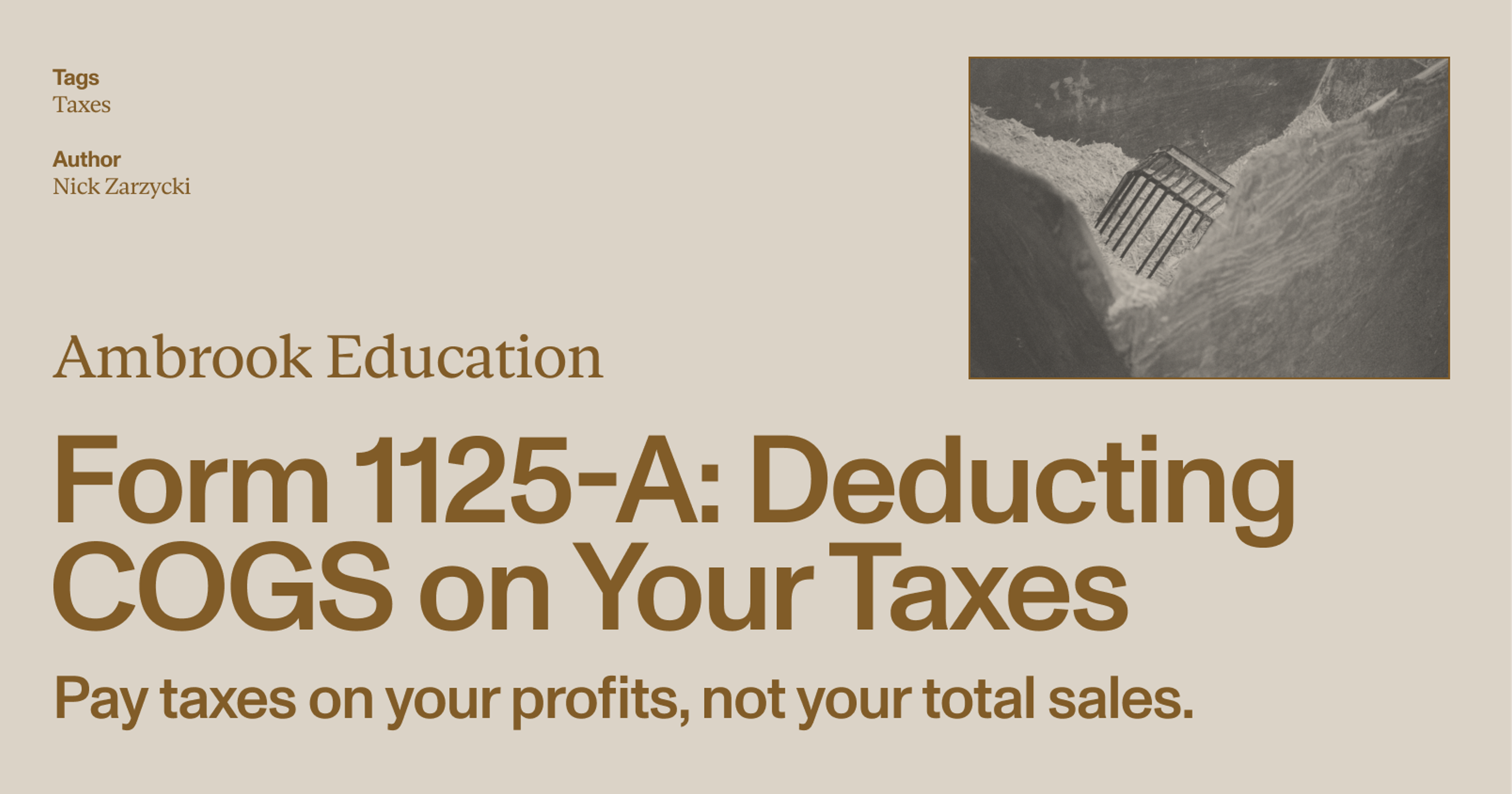A straightforward guide to making the most of the mileage rate deduction for your farm.
The standard mileage rate for 2025 is 70 cents per mile, and that applies to all vehicles used in the business of farming.
You may be able to reduce your tax burden further by using the actual costs method of deduction. But whether you use the standard rate or the actual costs method, good record keeping is essential in case of a potential IRS audit.
Here’s how to choose the best farm vehicle deduction for your business, and a few tricks to make record keeping simpler.
Standard mileage rate. vs actual costs
You have two options for deducting farm vehicle expenses: The standard mileage rate and the actual costs method.
The standard mileage rate is typically easier to calculate: You don’t need to keep detailed records of vehicle expenses, only a mileage log.
That being said, unless you calculate your deduction using both methods, you won’t know which one will save you the most money on your taxes. So the thriftiest approach is to calculate both the standard mileage rate and the actual costs deduction, and choose the one that results in the largest deduction.
The standard mileage rate deduction
If you plan to use the standard mileage rate at any point in a vehicle’s lifetime, you must use it for the first year you claim mileage as a tax deduction. For subsequent years you can choose either the standard mileage rate or the actual costs method.
For 2025, the standard mileage rate is 70 cents per mile. For 2024 it was 67 cents and for 2023 it was 65.5 cents.
To claim the standard mileage rate deduction, you need to track the total number of miles you traveled in your vehicle for work purposes.
Here’s how to calculate your farm vehicle deduction using the standard mileage rate:
Add up the total miles you travelled in the vehicle for work purposes
Multiply the number of miles by the standard mileage rate for the tax year
On individual or sole proprietor tax returns, you deduct this amount on Schedule C of Form 1040.
The actual costs method of deduction
Using the actual costs method, you calculate how much you travelled in your vehicle for work purposes (represented as a percentage). You then multiply this percentage by your total vehicle expenses for the year.
In order to use the actual costs method, you need:
The total number of miles you travelled in your vehicle for business purposes during the course of the year
The total number of miles travelled for both business and non-business purposes over the course of the year
The total amount you spent on deductible vehicle expenses over the course of the year
Your total vehicle expenses may include the cost of:
Fuel
Insurance
Tires
Maintenance
Repairs
License plates
Depreciation
Rent or lease payments
Local and state vehicle taxes
Parking and tolls
When using the actual costs method, it’s essential that you keep records (receipts) of all the expenses you’re claiming. That includes everything from the cost of a couple quarts of oil to top up a truck with a leak to the cost of having your engine completely overhauled.
Here’s how to calculate your deduction with the actual costs method:
First, divide the number of miles travelled for work by the total miles travelled. This gives you what percentage of your vehicle’s use was for business purposes, represented as a decimal.
Add up all of your deductible vehicle expenses for the year.
Multiply them by the percentage represented as a decimal calculated in step 1. The result is your total deduction using the actual costs method.
Like the standard mileage deduction, you report this on Schedule C of Form 1040 if you are filing as an individual or a sole proprietor.
If this method sounds tricky, the example below should clarify things.
Standard mileage rate vs. actual costs method: An example
Suppose you use your truck both for work and for non-work purposes. In 2025, you travelled 32,000 miles total, with 18,000 of those miles being for work. Your total vehicle costs came to $13,000.
To calculate your deduction using the standard mileage rate, multiply 18,000 (total miles travelled for work) by 0.70 (the standard rate for 2025):
18,000 x $0.70 = $12,600The total amount you can deduct on your taxes using the standard mileage rate is $12,600.
Now calculate your deduction using the actual costs method.
To determine what percentage of your vehicle use was for work purposes, first divide 18,000 (miles travelled for work) by 32,000 (total miles travelled):
18,000 ÷ 32,000 = 0.56So, you used your vehicle for work purposes 56% of the time it was in use.
Then multiply this percentage (as a decimal) by $13,000, your total vehicle costs for the year:
0.56 x $13,000 = $7,280Your total deduction using the actual costs method comes to $7,280.
You stand to reduce your taxable income $5,320 more using the standard mileage rate. Everything else being equal, that’s the calculation method you should use.
When should you change your mileage deduction method?
In years when your total vehicle costs are either higher or lower than average, you may benefit from choosing a different calculation method.
For instance, following the example above: Suppose your truck needed major repairs in 2025, so your total vehicle costs came to $25,000 instead of $13,000.
In that case, the calculation for the actual costs method would now be:
0.56 x $25,000 = $14,000So you would stand to save more using the actual costs deduction than by applying the standard mileage rate.
These calculations may also be affected by factors including:
The number of miles travelled for work, and their ratio in comparison to miles travelled for non-work purposes
Increases or decreases in the cost of fuel
Decreasing fuel efficiency as a vehicle ages
Increasing repair and maintenance costs over time
The amount of weight typically being hauled or towed (which affects fuel efficiency)
What qualifies as a farm vehicle?
Any vehicle whose use is at least 50% applied to business purposes qualifies as a business vehicle.
That is, if at least half the miles you travel in a given year were for work purposes, you can deduct mileage on your tax return.
Business use for your farm or ranch includes travel both on your property (or leased land) and on public roads. That includes:
Harvesting crops
Cultivating land
Raising, managing, transporting, and caring for livestock
Transporting farm goods to market
Transporting supplies to your farm
Travelling on your farm in the course of doing farm work
Travel to business meetings and business-related events also qualifies as farm use.
How to use a mileage log
Whichever deduction method you choose, you need to keep an organized mileage log tracking how many miles you have travelled for work and how many miles you have travelled for business.
Even for vehicles that never leave your farm, a mileage log is essential for calculating your total deductible business use.
Your mileage log doesn’t just help you calculate your vehicle deduction. In the event of an IRS audit, it helps to prove that you’ve actually incurred the vehicle expenses you have claimed on your tax return.
For that reason, it’s important to keep both past mileage logs and receipts for vehicle expenses (when using the actual costs method) on file. In a typical audit, the IRS can request records going back at least three years. If they suspect you of fraud, they can request up to six years of expense records.
What should my mileage log include?
Your mileage log should include:
Odometer readings for the beginning and end of business trips
The total mileage travelled for each trip
Your destination
Vehicle expenses incurred
The total amount of each expense
Your mileage log can take the form of a physical log book or a spreadsheet on your computer. You may also choose to use an app with GPS tracking and digital records storage.
Read More: Audit-Proof Your Vehicles With This IRS Mileage Log Template
The farm vehicle safe harbor rule
You can take advantage of the safe harbor rule for work vehicles to simplify your tax deduction.
Under this rule (business use percentage), farmers can claim 75% of their total vehicle costs without keeping records of business use.
In the words of the IRS, to qualify, the vehicle must be used “during most of the normal business day directly in connection with the business of farming”.
Some caveats:
This method can only be applied to cars and light trucks (not heavy vehicles)
You must elect to use this method for the first tax year you claim the use of the vehicle as a tax deduction
After electing this method the first year you must use it for every subsequent year
Even after you’ve selected this method, if you can prove—by supplying records—that for a particular year your business use exceeded 75%, you may be able to claim more than the 75% deduction.
Ambrook helps you get the most mileage out of your tax deductions
Tracking vehicle expenses is easy when you use Ambrook. Each expense is automatically imported and categorized by your bookkeeping team. When it comes time to calculate your business vehicle deductions—and choose which method is right for you—the information you need is at your fingertips.
Plus, with time-saving bookkeeping automation features, automatically-generated financial reports, streamlined bill pay and invoicing, and other powerful accounting and financial management tools, Ambrook doesn’t just make expense tracking simple: it takes the guesswork out of running your business. Want to learn more? Schedule a demo today.
Want to learn more about Ambrook?
This resource is provided for general informational purposes only. It does not constitute professional tax, legal, or accounting advice. The information may not apply to your specific situation. Please consult with a qualified tax professional regarding your individual circumstances before making any tax-related decisions.






